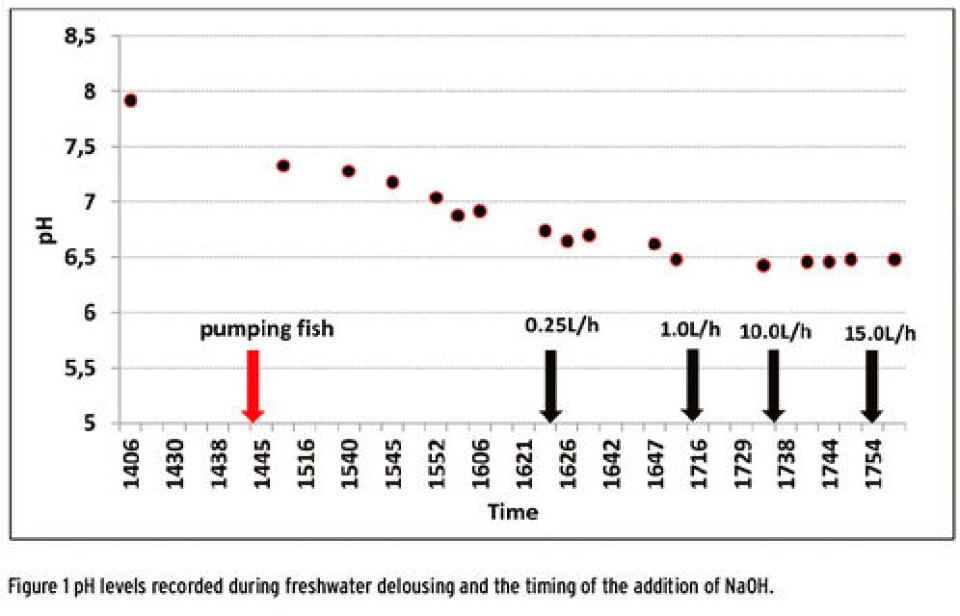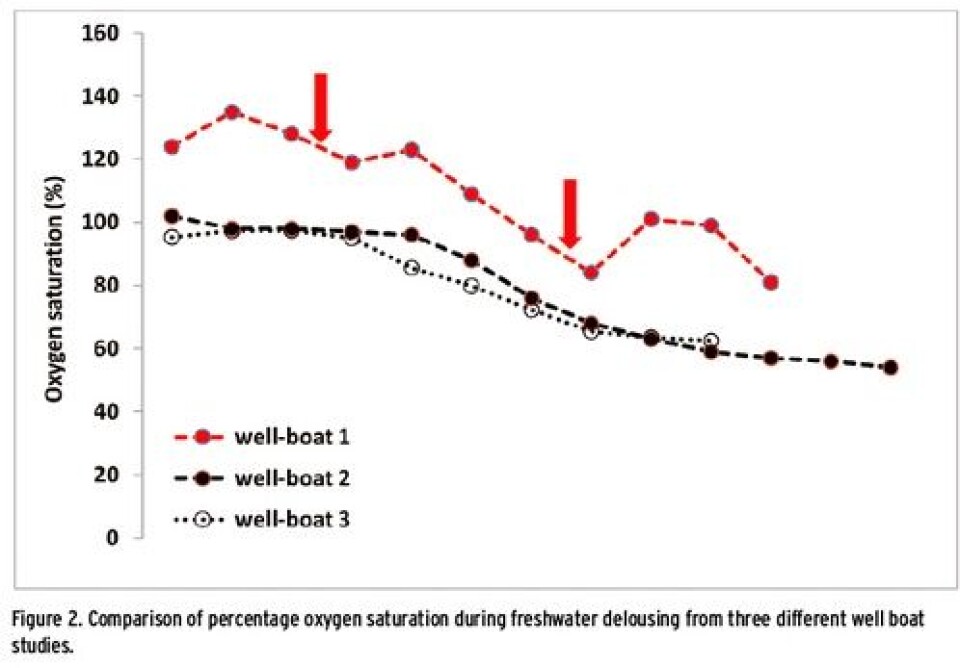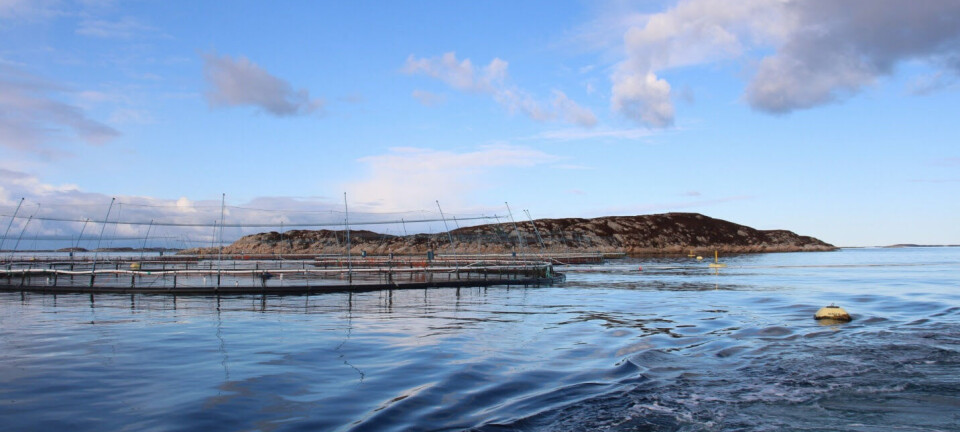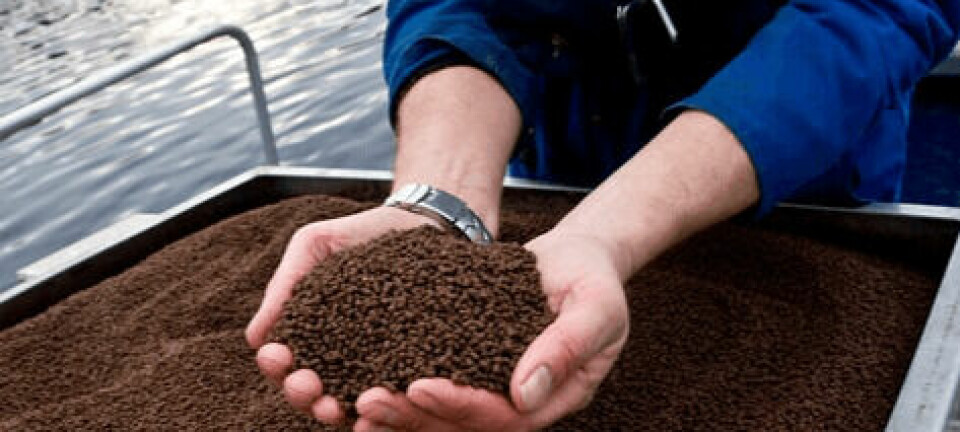Freshwater delousing in well-boats, Part III
PATRICK REYNOLDS; GERHARD ELIASSEN; RONALD JØRGENSEN, GILDESKÅL FORSKNINGSSTASJON pat.reynolds@gifas.no
This is the fourth study in a suite assessing the potential use of freshwater as a delousing agent under commercial conditions using well-boats. Previous studies showed that a significant biomass of Atlantic salmon (up to 110 T) could be successfully deloused with freshwater. However, the studies also highlighted the need to maintain water quality parameters such as dissolved oxygen and particularly pH in order for the attached sea lice to be exposed to freshwater for sufficient time in order to be affected. Previous studies have shown that dissolved oxygen decreases rapidly during exposure to freshwater and on-board oxygen delivery systems vary in their ability to maintain safe saturation levels dependent upon which well-boat is used. In addition, from all studies undertaken to date, decreasing pH levels have led to shorter than desired exposure times in freshwater. Fish respiration can raise carbon dioxide levels high enough to interfere with oxygen intake by fish, in addition to lowering the pH of the water.

If freshwater is to be used as an effective delousing treatment then control of dissolved oxygen and pH is critical to ensure effective exposure times and maintenance of fish welfare.
A potential option to prevent swings in pH is to add Sodium hydroxide (NaOH), also known as caustic soda, lye/lut solution or Sodium Hydrate solution. It is a highly caustic metallic base and alkali salt which is available as a prepared solution at a number of different concentrations. Sodium hydroxide forms an approximate 50% (by weight) saturated solution with water. It is commonly used at smolt facilities which use recirculation systems to help maintain safe pH levels throughout production.
The aims of this study were to assess the potential of using a buffering agent (NaOH) to maintain safe levels of pH when treating a large biomass of salmon in freshwater for a defined period of time and assess which oxygen delivery systems are suitable for use when delousing in freshwater.
Methods A study was conducted at GIFAS large-scale facilities at Stivika in December 2013 using Brønnbåten Novatrans.
For the study, one 600 m3well was filled with freshwater (0.0 ppt) Freshwater was pumped into the well from Sundsfjord smolt the previous evening/early morning before arriving at the farm site. Approximately 30,000 Atlantic salmon with a mean weight of 1.0 kg (30.3 T) were used in the study. As the fish were pumped into the well, excess seawater was removed via a grid to ensure that the salinity in the well was maintained during the treatment period. The time required to transfer the fish into the wells was recorded and transfer from first to last fish in took two hours and twenty minutes.
From three previous studies undertaken at Gifas, comparisons of the suitability of oxygen delivery systems on board each well-boat were made. Percentage oxygen saturation was recorded periodically throughout for each study.

Results The main aim of this study was to assess the potential of NaOH in maintaining safe levels of pH when treating a large biomass of salmon in freshwater for a define period of time. Previous studies have shown that pH levels steadily decreased during the exposure period and fish have shown signs of acute stress as a result of this steady decrease in pH. Without a buffering system, free carbon dioxide will form large amounts of a weak acid (carbonic acid) that may potentially decrease the pH level. Results from the study show that initially there was a steady but small decrease in pH in the well once fish transfer had been complete and prior to the addition of NaOH. The addition of NaOH commenced approximately I hr. and 30 minutes after the fish had been transferred to the well at a rate of 0.25 l/hr. The decline in pH slowed after the addition of NaOH in the well containing freshwater and then increased slightly after 10 minutes post-addition (figure 1). The rate of NaOH solution was increased up to 25.0 l/hr and there were corresponding small increases in pH levels in the well.
The results from the study indicate that the addition of NaOH can assist in maintaining safe levels of pH throughout the treatment period but must be added much sooner at a higher rate to prevent pH levels falling too low. The total amount of NaOH added to the well was approximately 6.0 litres throughout the treatment period. Further studies should involve the use of one pump per well (if more than one well is to be used) and maximum flow rates of the pumps used should be up to 30l/hour to maintain good buffering potential. It is proposed that pH levels of between 6.8 and 7.0 should be maintained if possible throughout the treatment period (in the range of approximately three hours) to achieve good clearance rates from all infectious stages of L.salmonis.
Results from the comparisons of the different oxygen delivery systems used on the three different well boats can be seen in figure 2.
Results from well boat studies two and three show that there was a steady decrease in oxygen saturation during the treatment period. Oxygen concentration levels decreases to less than 54% for well boat 2 and to less than 63% for well-boat three during freshwater delousing. The oxygen delivery systems on board these two well boats were unable to re-oxygenate the freshwater during the exposure period and as a result both studies were stopped and seawater was pumped into the well to re-oxygenate and exchange the freshwater in the well. Results from the study on well-boat 1 show that oxygen saturation levels were maintained throughout the treatment period. Oxygen saturation levels decreased from 124.0% at the start of the exposure study to a low of 84.0%. However, as oxygen saturation levels decreased, levels were quickly elevated when the delivery systems was activated. The delivery systems on well-boats two and three were of similar design and were unable to diffuse oxygen into the freshwater, however, well-boat one had a super-saturation system on board which was able to maintain suitable saturation levels during freshwater delousing.
Summary/Conclusions This present study showed that there is potential for NaOH to be used as a buffering agent to control pH in wells filled with freshwater. However, further research is required to elucidate flow rates and how much to add to maintain safe levels throughout a desired treatment period of approximately three hours.
Comparison of the oxygenation systems available on well-boats show that not all systems are the same and that only certain ones are able to maintain safe levels of oxygen. This represents a potential problem in terms of availability if only certain well-boats can be used to delouse with freshwater and further work is required to achieve a solution to this problem.























































